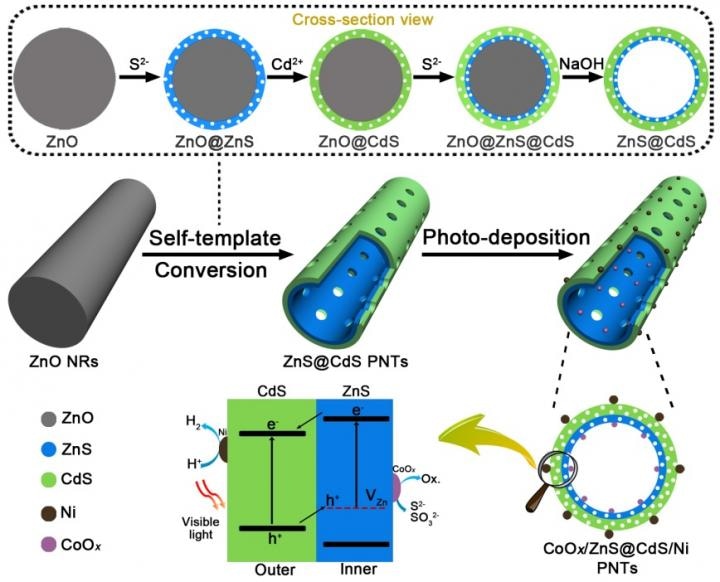Jun 7 2018
Using solar energy to convert water into hydrogen (H2) through photocatalysis is believed to be an attractive method for producing H2. However, to enhance the efficiency of photocatalytic hydrogen production, the separation efficiency of charge carriers is very important.
 Self-template synthesis of ZnS@CdS PNTs and successive in situ photo-deposition synthesis of CoOx/ZnS@CdS/Ni PNTs, and Schematic illustration of photocatalytic H2 production process in CoOx/ZnS@CdS/Ni PNTs. (Image credit: ©Science China Press)
Self-template synthesis of ZnS@CdS PNTs and successive in situ photo-deposition synthesis of CoOx/ZnS@CdS/Ni PNTs, and Schematic illustration of photocatalytic H2 production process in CoOx/ZnS@CdS/Ni PNTs. (Image credit: ©Science China Press)
According to a recent study, self-template strategy was applied to synthesize the double-layered porous nanotubes that have spatially separated photoredox surfaces. These showed improved photocatalytic activity toward H2 production.
Prof. Bin Zhang from Tianjin University has described the study in Science Bulletin 2018, 63(10):601-608, entitled "Self-template synthesis of double-layered porous nanotubes with spatially separated photoredox surfaces for efficient photocatalytic hydrogen production".
ZnS@CdS double layered porous nanotubes with spatially separated photoredox surfaces were synthesized by the authors. To achieve this, ZnO nanorods (NRs) were used as templates via template etching and sequentially interfacial cation/ anion exchange reactions. The photo-oxidation deposition of CoOx nanoparticles were distributed on the inner surface of ZnS@CdS shell, and the photo-reduction deposition of Ni nanoparticles were distributed on the outer surface. This indicates the spatially separated photoredox reaction sites in ZnS@CdS double-layered shell, realizing highly improved photocatalytic activity.
In recent years, the outbreak of the energy crisis has made it highly significant to develop new energy. While using solar energy to convert water into H2 through photocatalysis is considered to be a viable method for producing H2, the separation efficiency of charge carriers is important for enhancing the efficiency of photocatalytic production of H2. One effective approach to promote charge separation and generate surface redox reaction sites is loading cocatalysts. Yet, in majority of cases, the cocatalysts, which are arbitrarily distributed on the photocatalysts’ surface, led to a haphazard flow direction of photogenerated charge carriers with a high recombination possibility.
The coherent design of hollow-nanostructured photocatalysts, with spatially separated photo-oxidation and photo-reduction reaction sites on varying surfaces (outer or inner surfaces), respectively, appears to be a promising method. However, these photocatalysts are invariably limited to hollow spheres with close-ended structure which, in turn, raised the mass diffusion resistance; also their practical application is limited by the high-cost of Pt nanoparticles utilized as the electron collector.
Here, a self-template strategy was reported by the Zhang team for rationally designed synthesis of double-layered ZnS@CdS porous nanotubes (PNTs) that are known to have open-ended structure. The fabrication of thin heterostructure imparts the photocatalysts with spatially separated oxidation and reduction reaction surfaces. Within the as-converted products, the macroporous cavity and mesoporous wall enable the penetration of visible light as well as multiple reflections within the cavity to ensure that solar irradiation is efficiently utilized. Zn vacancies (VZn) exist in the inner ZnS layer states energy which can serve as acceptors of holes from CdS. Moreover, CdS’ conduction band (CB) is below the CB of ZnS, which means this can promote the enrichment of photogenerated electrons in the outer CdS layer.
Following selective photo-deposition of CoOx and Ni as dual cocatalysts, the outer shell, is loaded with Ni nanoparticles as electron collectors and reduction reaction sites, while the inner shell is loaded with CoOx nanoparticles as hole collectors and oxidation reaction sites. As a consequence, a new CoOx/ZnS@CdS/Ni photocatalyst was achieved and exhibited high photocatalytic hydrogen production activity driven by visible light due to the synergistic effect of photo-deposition-derived spatially separated dual cocatalysts and self-template-derived thin mesoporous heterojunctions, which can considerably provide a driving force for the controlled transfer of photogenerated electrons and holes toward opposite direction, thus promoting the surface catalytic reaction.